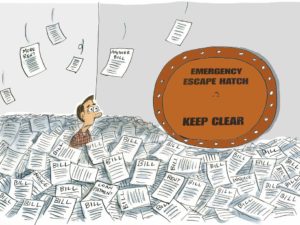Problems and solutions are part of our everyday lives. We are either busy solving our problems or someone else’s problems or sometimes we are just busy creating one for ourselves even though there’s isn’t any problem. These problems can range from emotional to mental or even financial problems.
Without being aware, we’ve also set a pattern to approaching a said problem and seeking solutions for the same. While seeking for solutions, we look for immediate or short-term solutions that’ll help solve the problem at least on a temporary basis instead of focussing on addressing the root of the problem; that is seeking long-term solution. In this manner we ourselves become the carriers of our future problems.
Integrative thinking is a creative manner of thought process that helps to find solutions for the current problems along with solutions to probable or potential problems that may arise in the future.
 (P.C: Pexels.com)
(P.C: Pexels.com)
By focussing more on the root of the problem, integrative thinking encourages one to think beyond, look at various other alternatives, analyse how can things be done differently and what impacts will each action have before taking an informed and logical decision. In this manner, it helps one to stretch their thinking and build a safety valve for possible problems of the future. The process of integrative thinking may take more time to find the appropriate solution but this solution will be a wholesome solution.
How can one apply integrative thinking when faced with serious financial problems, especially for overcoming a debt trap?
 (P.C: Google Images)
(P.C: Google Images)
INTERGRATIVE THINKING=STANCE.TOOLS.EXPERIENCE
In simplified terms, it can be broken down as:
- STANCE: How to leverage what you have currently with you?
- TOOLS: Using your imagination to forecast probable problems, solutions and alternatives
- EXPERIENCE: How would you have treated the challenge in the past, how you would treat it now and how is it treated around the world?
Let’s take a case study to better understand how to use integrative thinking while faced with financial problems:
Mr. Raj is a doctor and owns a hospital that aids to the needs of the poor people. One fine day, he suddenly realises that his hospital was in deep debt. Upon calculating it was disclosed that his monthly cash flow deficit is Rs. 7 lakhs.
How can Mr. Raj apply integrative thinking process here?
 (P.C: Pexels.com)
(P.C: Pexels.com)
Mr. Raj who normally would’ve applied for another loan to pay out the mounting debt however decided to approach the situation at hand differently.
- He first jotted down his main sources of income and expenditure. He then differentiated between necessary and unnecessary expenses and decided to stop unnecessary expenses.
- He further looked into different possibilities of generating extra income with what he has at hand. In order to leverage what he already has, he decided to looks at avenues which can work favourably for him. He noticed that some space in the hospital was unutilized or rather underutilized. He therefore decided to fully put to use the resources which he has so that he can not only repay his debt but also generate extra income every month. In order to achieve this, he leased out the unused or the underutilised space to outside doctors who could set up their private practise along with purchasing the right machinery equipment for taking tests (which were otherwise done outside by the patients).
- A small space was converted into pharmaceutical shop.
In this manner he was able to generate extra income to not only pay his mounting debt but also generate constant source of income with hardly any cost. Mr. Raj looked at his challenge as an opportunity to expand and grow himself which acted as a driving force for him to explore other avenues.
Each of us at some point has applied a portion of this stream of thinking unconsciously. However when it’s leveraged in whole, it’ll open our eyes to diverse options, each having varying potentials to address the given problem. However such a method is usually advisable to apply when the issue at hand is very complex or grave. Through this manner of thinking, a challenge is not a challenge; it’ll be looked at as an opportunity to expand. So next time when you face a significant challenge don’t forget to apply integrative thinking as a solution provider!

